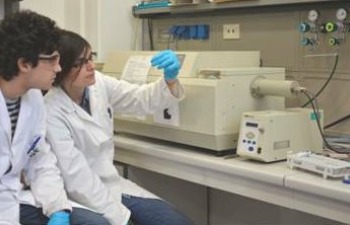View All Molecular Biophysics at Instruct
The CERM/CIRMMP platform provides instruments and services leading to the biophysical characterisation of biomolecules and the sample quality control using Dynamic Multi Angle Light Scattering (MALS-QELS) and circular dichroism (CD).
Cary Eclipse with Plate Reader
System components available on Multi Angle/Dynamic Light Scattering MALS-RI-QELS on line: 1) Multi-angle light scattering detector: DAWN EOS from Wyatt Technology. Equipped with the QELS module which enables measurement of the hydrodynamic radius; 2) Differential Refractive Index (dRI) detector: Optilab rEX from Wyatt Technology; 3) Chromatography system: Knauer isocratic HPLC system. The HPLC is synchronized with the light scattering detector and refractive index to allow synchronization of data from optical sensors with the chromatographic peaks.
Jasco J-810 is equipped with 150 W air cooled Xenon lamp with a theoretical detection range 163 – 900 nm, automated temperature control unit (Peltier) and Jasco software for spectra recording and analysis.
MALS-QELS is a straightforward technique to determine the accurate molar mass and the size of proteins and macromolecular complexes in solution. MALS-QELS can measure the absolute molar mass and size of molecules without the use of reference standards. One of the major application is the determination of the size and stoichiometry of tightly bound hetero-complexes, such as protein/protein, protein/DNA, protein/RNA and protein/detergent interactions.
The MALS-QELS technique available at the CERM/CIRMMP platform offer the possibility to analyse aggregation state of proteins and protein mixtures. Measurements can be performed with SEC separation column (HPLC) or in on batch mode. Samples volume range from 20 to 200 uL or more. Samples need to be deeply filtered and centrifuged to remove dust and small particles. All common buffers and additives are allowed for the measurements. The sample can be back collected after the experiments.
UV-CD is an excellent technique for studying conformational changes adopted by proteins and nucleic acids in solution as function of temperature, pH and concentration, to determine the secondary structure of proteins and peptides. Though unable to give detailed insights into the tertiary structure of a protein, UV-CD can be useful in complementing other structural techniques.
The far-CD technique at CERM /CIRMMP platform offers several type of applications ranging from the determination of secondary structure elements, thermal stability analysis, studies of proteins unfolding caused by heat. Measurement of CD spectrum for the determination of secondary structure of protein requires 160 μl of 0.1-0.2 mg/ml protein solution; for the determination of DNA conformation requires 160 μl of 20 μM of solution or 1400 μl of 2 μM solution. For better results, the buffer alone should not have a high absorbance in the region of the spectrum (far or near-UV). For instance, high concentrations of dithiothreitol, glycerol, DMSO, histidine, imidazole etc. cannot be used in the far-UV region. The chloride ion as buffer component is not recommended with CD experiments and should therefore be kept as low as possible within the limit of acceptability for the molecule stability.
Visible-CD is a very powerful technique to study metal protein interactions. Visible-CD can resolve the individual transitions as separate bands, particularly where the CD bands are of opposite sign.
The visible-CD spectroscopy at CERM /CIRMMP platform can be applied for studies of binding of metals to proteins/peptides/DNA. Unlike absorption spectra, CD spectra are only produced where a metal ion is in a chiral environment. In this way, the use of visible-CD has the advantage of being immune from interference by free metal ions, as only the protein-bound species are observed. The buffer can contain high concentrations of organic molecules/salts, i.e DTT, imidazole, NaCl etc.


